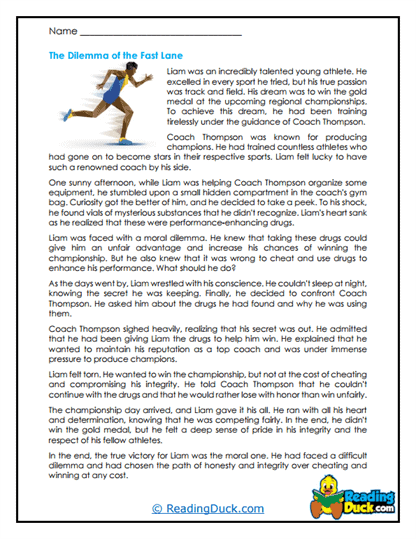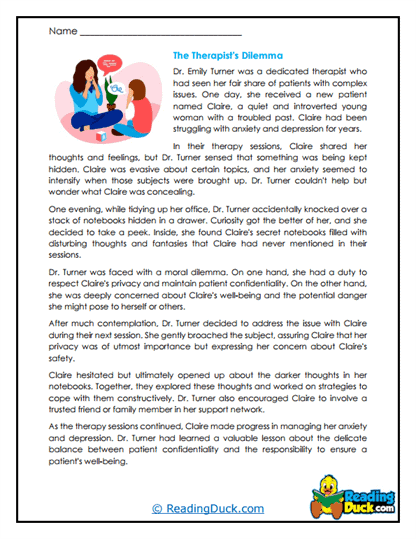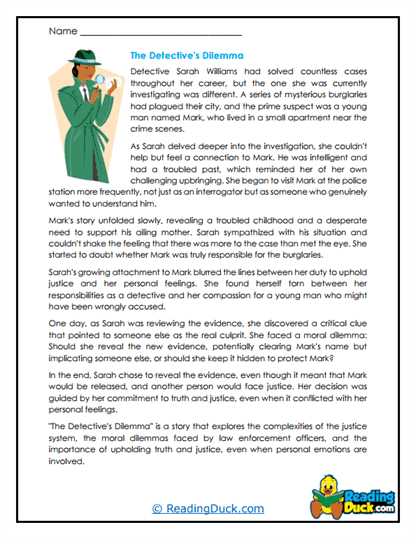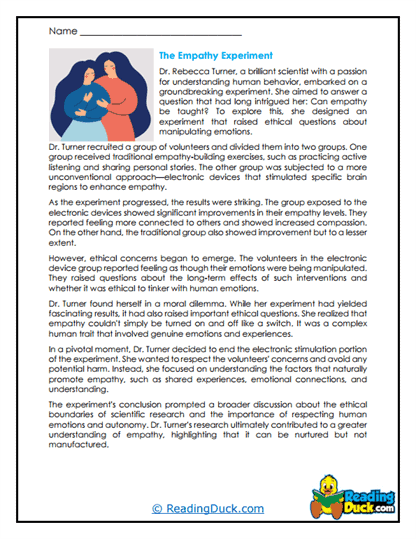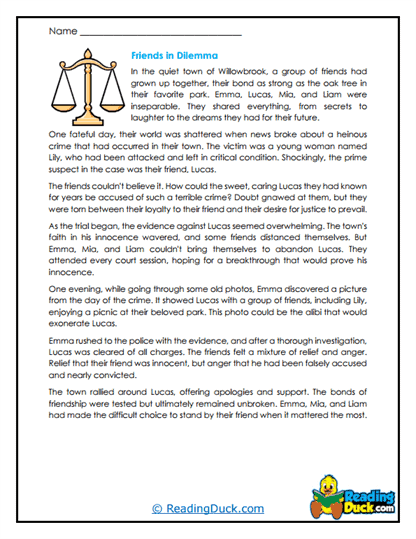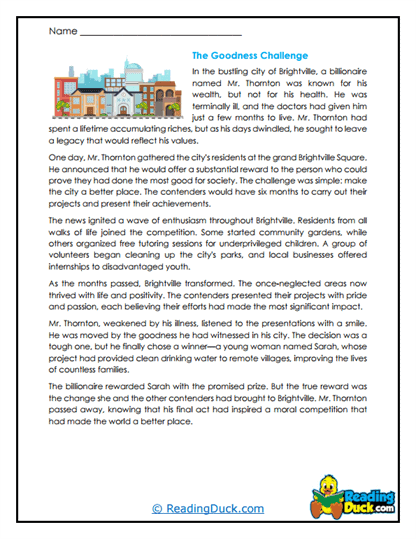Moral Drama Worksheets
About Our Moral Drama Worksheets
Our Moral Drama Worksheets offer an in-depth exploration of dramatic works that challenge characters—and by extension, students—to grapple with complex ethical dilemmas, personal integrity, and the consequences of moral choices. Each worksheet set includes a reading passage that exemplifies the central themes of the moral drama genre, followed by a range of multiple-choice, short-answer, and open-ended response questions. These worksheets are designed to help students critically engage with the material while fostering essential skills in reading comprehension, critical thinking, and creative expression.
Delivered in PDF format, these worksheets are easy to view, download, and print for use in both the classroom and at home. Each worksheet also comes with a downloadable answer key for quick and efficient grading, allowing educators to facilitate deeper discussions and prompt students to think more critically about the moral questions posed in the drama. Whether you're introducing students to the complexities of moral decision-making through literature or using these worksheets to support a larger unit on drama, they provide a rich and versatile educational resource.
Exploring the Themes and Structure of Moral Drama
Moral drama is a genre that focuses on ethical dilemmas, highlighting the internal and external conflicts that arise when characters are faced with difficult decisions that test their moral values. These dramas often delve into profound questions about justice, honor, personal integrity, and the consequences of one's actions. Through nuanced storytelling, moral dramas challenge audiences to reflect on how societal norms, personal beliefs, and external pressures influence human behavior.
Key themes in moral drama include:
- Moral conflict: Characters in moral dramas often face a choice between right and wrong, with decisions that carry significant personal or social consequences.
- Consequences of actions: These stories frequently explore the ripple effects of a character's decisions, highlighting how one choice can alter the lives of many.
- The tension between personal values and societal expectations: Characters are often caught between their own moral code and the demands or judgments of society.
- Redemption and guilt: Many moral dramas focus on characters seeking redemption for past mistakes or struggling with the weight of guilt after making a morally ambiguous decision.
Our Moral Drama Worksheets guide students through these intricate themes by providing reading passages that encapsulate the tension and depth of moral dilemmas. Each worksheet encourages students to analyze how characters navigate their ethical choices, how their decisions impact others, and how the plot reflects larger societal questions. These passages invite students to reflect not only on the characters’ internal struggles but also on the broader implications of morality in literature and life.
Developing Critical Thinking Through Analysis
The Moral Drama Worksheets are designed to stimulate critical analysis by encouraging students to engage with both the moral dilemmas within the text and the dramatic techniques used to convey those conflicts. Through a mix of multiple-choice, short-answer, and open-ended response questions, students will sharpen their ability to think critically about the characters’ motivations, the ethical stakes, and the moral lessons woven into the story.
The structure of the worksheets includes:
- Multiple-choice questions: These questions test students’ understanding of key plot points and character decisions, helping to reinforce comprehension. For example, students may be asked to identify which ethical dilemma a character faces or choose the outcome of a pivotal decision that drives the story forward.
- Short-answer questions: These prompts encourage students to delve deeper into the text by explaining the reasons behind a character’s moral choice or by analyzing how a specific action affects the narrative. For instance, students might explain how societal pressure influences a character’s decision to act against their own beliefs.
- Open-ended response questions: These questions invite students to think broadly and reflectively about the text’s moral themes. They may be asked to explore how the drama reflects real-life ethical challenges or to debate whether the character’s final decision was justified in the context of the story.
This balance of factual comprehension and creative engagement ensures that students not only understand the events of the passage but also think critically about the ethical dimensions of the story. By examining the characters' moral struggles, students learn to approach complex issues with a more nuanced perspective, developing their analytical skills in the process.
Encouraging Group Discussions and Peer Collaboration
Moral dramas often present thought-provoking ethical dilemmas that are perfect for group discussions and collaborative learning. The Moral Drama Worksheets are designed to foster a classroom environment where students can engage with their peers, share interpretations, and discuss the larger implications of the characters’ decisions. Through these discussions, students are encouraged to challenge each other’s perspectives, explore different viewpoints, and deepen their understanding of the moral themes in the text.
Classroom activities that can be enhanced through these worksheets include:
- Debating moral decisions: After completing the worksheet, students can be asked to debate whether the character’s choice was ethically sound, using evidence from the text to support their arguments. This allows students to explore different interpretations of the moral dilemma and sharpen their reasoning skills.
- Analyzing character motivations: In small groups, students can analyze the factors that influenced a character’s decision, discussing how personal beliefs, societal expectations, or external pressures shaped the outcome.
- Exploring alternative outcomes: Students can work together to imagine how the story might have changed if the character had made a different choice, exploring the consequences of alternative actions.
These collaborative discussions help students see the complexity of moral dilemmas from various angles, promoting a deeper engagement with the text. Additionally, by hearing different perspectives, students develop their ability to articulate ideas and debate ethical issues, further enhancing their critical thinking and communication skills.
Promoting Creative Expression and Active Learning
In addition to encouraging analysis and discussion, the Moral Drama Worksheets also offer students opportunities for creative expression and active learning. The genre of moral drama naturally lends itself to activities that allow students to explore their own interpretations of the text, whether through writing, performance, or other creative projects.
Some creative activities inspired by the worksheets include:
- Writing alternate endings: After completing the reading passage, students can write their own ending to the story, imagining how the drama might unfold if the character had made a different moral choice.
- Character diaries: Students can write a series of diary entries from the perspective of the main character, reflecting on their internal struggles and the moral challenges they face throughout the narrative.
- Scene re-enactments: Teachers can have students act out key scenes from the passage, encouraging them to focus on how tone, body language, and dialogue convey the moral tension in the story.
These active learning exercises give students the opportunity to explore the moral dilemmas of the text in more personal and imaginative ways. By engaging with the material through writing and performance, students develop a deeper connection to the ethical questions posed in the drama, making the learning experience more dynamic and engaging.
Extending Learning with Complementary Projects
The Moral Drama Worksheets serve as an excellent foundation for extended projects that help students further explore the ethical themes introduced in the reading passages. These complementary projects allow students to apply their understanding of the genre in creative and interdisciplinary ways, deepening their engagement with the material.
Project ideas that complement the worksheets include:
- Creating ethical dilemma scenarios: After completing the worksheet, students can be tasked with writing their own short plays or stories that feature a moral dilemma. This allows them to apply what they’ve learned about character development and ethical conflict while crafting their own narratives.
- Comparing moral dramas from different cultures or time periods: Students can research moral dilemmas presented in dramas from other cultures or historical contexts, comparing how different societies approach similar ethical issues.
- Research projects on real-life moral dilemmas: Students can choose a real-world ethical issue and present a report or project on how it relates to the themes explored in the moral drama worksheet, making connections between literature and current events.
These projects not only help students extend their learning beyond the worksheet but also encourage them to think critically about how moral dilemmas are relevant in both literary and real-world contexts.
Integrating Moral Drama Worksheets into the Curriculum
The Moral Drama Worksheets are a versatile educational resource that can be easily integrated into a variety of units on literature, drama, or ethics. They are ideal for introducing students to the complexities of moral decision-making in drama and can be used to analyze dramatic texts or as part of a larger thematic exploration of ethical conflicts.
Educators can use these worksheets in several ways:
- As part of a drama or literature unit: Introduce students to the moral drama genre, exploring how playwrights and authors use ethical dilemmas to create tension and drive the narrative.
- To support lessons on character development: Focus on how moral dilemmas reveal the deeper values and motivations of characters, providing a rich source of material for character analysis.
- For individual assessments or group projects: Use the worksheets as a tool to assess students’ understanding of the moral themes, or as a starting point for group discussions, debates, or creative projects.
The worksheets are perfect for both formative assessments, helping students develop their analytical skills throughout the lesson, and summative assessments, providing a final evaluation of their comprehension and engagement with the moral drama genre.
Conclusion
Our Moral Drama Worksheets provide an engaging and thought-provoking way for students to explore the ethical dilemmas and internal conflicts that drive this powerful genre. By combining critical analysis with creative exploration and collaborative learning, these worksheets offer a comprehensive educational experience that encourages students to think deeply about the moral complexities found in literature. Delivered in PDF format with answer keys for easy use, these worksheets are a versatile resource that enhances any classroom study of drama, literature, or ethics.

